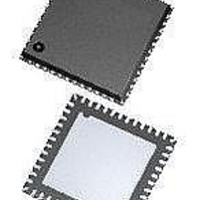MC9S08JM16CGT Freescale Semiconductor, MC9S08JM16CGT Datasheet - Page 323

MC9S08JM16CGT
Manufacturer Part Number
MC9S08JM16CGT
Description
MCU 8BIT 16K FLASH 48-QFN
Manufacturer
Freescale Semiconductor
Series
HCS08r
Datasheet
1.DEMO9S08JM16.pdf
(386 pages)
Specifications of MC9S08JM16CGT
Core Processor
HCS08
Core Size
8-Bit
Speed
48MHz
Connectivity
I²C, LIN, SCI, SPI, USB
Peripherals
LVD, POR, PWM, WDT
Number Of I /o
37
Program Memory Size
16KB (16K x 8)
Program Memory Type
FLASH
Ram Size
1K x 8
Voltage - Supply (vcc/vdd)
2.7 V ~ 5.5 V
Data Converters
A/D 8x12b
Oscillator Type
External
Operating Temperature
-40°C ~ 85°C
Package / Case
48-QFN Exposed Pad
Processor Series
S08JM
Core
HCS08
Data Bus Width
8 bit
Data Ram Size
1 KB
Interface Type
I2C, SPI
Maximum Clock Frequency
48 MHz
Number Of Programmable I/os
37
Number Of Timers
2
Operating Supply Voltage
2.7 V to 5.5 V
Maximum Operating Temperature
+ 85 C
Mounting Style
SMD/SMT
3rd Party Development Tools
EWS08
Development Tools By Supplier
DEMOJM, DEMOJMSKT, DEMOFLEXISJMSD, DEMO9S08JM16
Minimum Operating Temperature
- 40 C
On-chip Adc
12 bit, 8 Channel
Controller Family/series
HCS08
No. Of I/o's
37
Ram Memory Size
1KB
Cpu Speed
48MHz
No. Of Timers
2
Digital Ic Case Style
QFN
Rohs Compliant
Yes
Lead Free Status / RoHS Status
Lead free / RoHS Compliant
Eeprom Size
-
Lead Free Status / Rohs Status
Lead free / RoHS Compliant
Available stocks
Company
Part Number
Manufacturer
Quantity
Price
Company:
Part Number:
MC9S08JM16CGT
Manufacturer:
PIXART
Quantity:
1 001
Part Number:
MC9S08JM16CGT
Manufacturer:
FREESCALE
Quantity:
20 000
- Current page: 323 of 386
- Download datasheet (8Mb)
17.4.6
The USB supports a single low-power mode called suspend. Getting into and out of the suspend state is
described in the following sections.
17.4.6.1
The USB host can put a single device or the entire bus into the suspend state at any time. The MCU
supports suspend mode for low power. Suspend mode will be entered when the USB data lines are in the
idle state for more than 3 ms. Entry into suspend mode is announced by the SLEEPF bit in the INTSTAT
register.
Per the USB specification, a low-power bus-powered USB device is required to draw less than 500 µA in
suspend state. A high-power device that supports remote wakeup and has its remote wake-up feature
enabled by the host can draw up to 2.5 mA of current. After the initial 3 ms idle, the USB device will reach
this state within 7 ms. This low-current requirement means that firmware is responsible for entering stop3
mode once the SLEEPF flag has been set and before the USB module has been placed in the suspend state.
On receipt of resume signaling from the USB, the module can generate an asynchronous interrupt to the
MCU which brings the device out of stop mode and wakes up the clocks. Setting the USBRESMEN bit in
the USBCTL0 register immediately after the SLEEPF bit is set enables this asynchronous notification
feature. The USB resume signaling will then cause the LPRESF bit to be set, indicating a low-power
SUSPEND resume, which will wake the CPU from stop3 mode.
During normal operation, while the host is sending SOF packets, the USB module will not enter suspend
mode.
17.4.6.2
There are three ways to get out of the suspend state. When the USB module is in suspend state, the resume
detection is active even if all the clocks are disabled and the MCU is in stop3 mode. The MCU can be
activated from the suspend state by normal bus activity, a USB reset signal, or upstream resume (remote
wakeup).
17.4.6.2.1
The host signals a resume from suspend by initiating resume signaling (K state) for at least 20 ms followed
by a standard low-speed EOP signal. This 20 ms ensures that all devices in the USB network are awakened.
After resuming the bus, the host must begin sending bus traffic within 3 ms to prevent the device from
re-entering suspend mode.
Depending on the power mode the device is in while suspended, the notification for a host initiated resume
will be different:
Freescale Semiconductor
•
•
Run mode — RESUME must be set after SLEEPF becomes set to enable the RESUMEF interrupt.
Then, upon resume signaling, the RESUMEF interrupt will trigger after a K-state has been
observed on the USBDP/USBDN lines for 2.5 µs.
Stop3 mode — USBRESMEN must be set after SLEEPF becomes set to arm the LPRESF bit.
Then, upon a K-state on the bus while the device is in stop3 mode, the LPRESF bit will be set,
Suspend/Resume
Suspend
Resume
Host Initiated Resume
MC9S08JM16 Series Data Sheet, Rev. 2
Universal Serial Bus Device Controller (S08USBV1)
323
Related parts for MC9S08JM16CGT
Image
Part Number
Description
Manufacturer
Datasheet
Request
R
Part Number:
Description:
Manufacturer:
Freescale Semiconductor, Inc
Datasheet:
Part Number:
Description:
Manufacturer:
Freescale Semiconductor, Inc
Datasheet:
Part Number:
Description:
Manufacturer:
Freescale Semiconductor, Inc
Datasheet:
Part Number:
Description:
Manufacturer:
Freescale Semiconductor, Inc
Datasheet:
Part Number:
Description:
Manufacturer:
Freescale Semiconductor, Inc
Datasheet:
Part Number:
Description:
Manufacturer:
Freescale Semiconductor, Inc
Datasheet:
Part Number:
Description:
Manufacturer:
Freescale Semiconductor, Inc
Datasheet:
Part Number:
Description:
Manufacturer:
Freescale Semiconductor, Inc
Datasheet:
Part Number:
Description:
Manufacturer:
Freescale Semiconductor, Inc
Datasheet:
Part Number:
Description:
Manufacturer:
Freescale Semiconductor, Inc
Datasheet:
Part Number:
Description:
Manufacturer:
Freescale Semiconductor, Inc
Datasheet:
Part Number:
Description:
Manufacturer:
Freescale Semiconductor, Inc
Datasheet:
Part Number:
Description:
Manufacturer:
Freescale Semiconductor, Inc
Datasheet:
Part Number:
Description:
Manufacturer:
Freescale Semiconductor, Inc
Datasheet:
Part Number:
Description:
Manufacturer:
Freescale Semiconductor, Inc
Datasheet:











